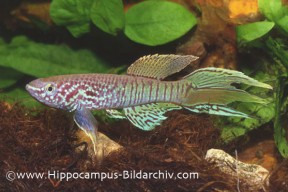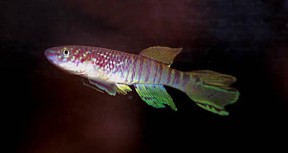Fundulopanchax sjoestedti
Golden Pheasant
Classification
Aplocheilidae
Distribution
Nigeria and Cameroon.
Habitat
Inhabits swampy parts of coastal rainforests.
Maximum Standard Length
4.8″ (12cm).
Aquarium SizeTop ↑
36″ x 12″ x 12″ (90cm x 30cm x 30cm) – 80 litres.
Maintenance
A dark substrate such as peat moss or similar should be used and the tank should have dense areas of planting and pieces of wood to serve as cover. The use of floating plants to further diffuse the light is also recommended. The species is an accomplished jumper so the cover must be very tight fitting.
Water Conditions
Temperature: 73-79°F (23-26°C)
pH: 6.0-8.0
Hardness: 5-20°H
Diet
Small live or frozen foods such as daphnia or bloodworm should form the basis of the diet. Dried foods are accepted only occasionally.
Behaviour and CompatibilityTop ↑
F. sjoestedti can be kept with peaceful species too large to be considered food. Good tankmates include peaceful cichlids, larger characins, Corydoras catfish and Loricariids. Males are aggressive towards one another and sufficient space must be provided if more than one is to be kept together. Females should be kept in small groups of 2 or 3 per male as they may be harassed quite a lot otherwise.
Sexual Dimorphism
The male is the larger, more brightly coloured fish with extensions to the caudal, dorsal and anal fins. Female fish are smaller, plainer and rounder in the belly.
Reproduction
Possible. It’s a substrate spawner. There exist several different methods of spawning this fish in aquaria and much is down to personal preference. Space is certainly not an issue, though, and a trio can easily be spawned in an aquarium as small as 15″ x 8″ x 8″.
Many breeders do not use filtration in killi breeding setups but the use of a small, air-driven sponge filter to prevent stagnation is not a bad idea. Water should be soft and acidic pH 6.5 (although there are instances of this species being bred in water of up to pH 8.0) with a temperature of 74-77°F. The tank should be should not be lit, and peat filtration is useful.
The fish should be conditioned on a varied diet of live and frozen foods. It’s best to keep the sexes apart in separate conditioning tanks and selecting the best male and plumpest females before placing them in the spawning tank. This allows females to recover between spawnings. Eggs are deposited in the substrate in nature but in aquaria the spawning medium can either be a layer of peat moss on the floor of the aquarium, spawning mops or clumps of fine-leaved plants such as java moss. Using peat moss is generally considered to be the most productive method .
If water conditions are good and the fish are well conditioned, spawning should present no problems. The eggs can be left in the aquarium to hatch with the parents but some eggs and fry will be eaten. If you want to raise a good-sized group, the eggs should be removed. Each trio should only be allowed to spawn for a week or so before being returned to the conditioning tanks. The spawning process is hard on the fish (particularly the females) and they can become fatigued and weak if left for too long.
Once removed, the eggs can be incubated either in water or in peat moss. It has to be said that less eggs tend to fungus using the latter.
If incubating in water the eggs can be transferred to a small aquarium containing water from the spawning tank to a depth of 1-2 inches to which has been added 1-3 drops of methylene blue depending on volume. This container should be kept in darkness (the eggs are very sensitive to light) and checked daily for fungussed eggs, which should be removed with a pipette. The eggs will hatch in 21 days or so depending on temperature.
If incubating in peat moss, remove the moss from the aquarium and allow it to dry on newspaper for 2 or 3 hours. Then place it in a plastic bag (the zip-lock type is good) and keep it at a temperature of 70-75°F. If you are spawning several species or multiple broods, it is a good idea to label each bag with the date, hatching date and species to prevent any disasters.
Hatching can usually be induced by simply placing the eggs in the raising aquarium after 10-12 weeks The wetting of the eggs stimulates hatching. The fry have no visible yolk sac and can be fed brine shrimp nauplii or microworm from hatching with the introduction of larger and frozen varieties after 2 weeks or so. The water must initially be kept very shallow but the level can be raised as the fry grow.
NotesTop ↑
One of the most stunning killifish available, due to the sublime colouration of adult males combined with their impressive maximum size. It was formerly classified as Aphyosemion sjoestedti and much of the available literature still refers to it by this name. There are several colour forms available, including a smaller variety known as “Dwarf Red”.



